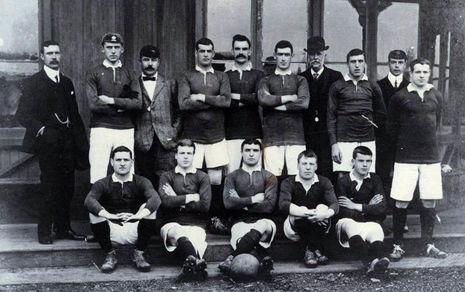Nottingham Forest, Arsenal, Sparta Prague, Atlético Independiente: Garibaldi and the redshirts of football
Looking back to the Italian Unification of the 19th century, Tom Bullivant explores the cultural effect of international hero, Giuseppe Garibaldi, on football teams across the world.

Garibaldi. If you know the name it’s probably because you’re partial to his biscuit namesake, a snack popular in the UK for over 150 years. It might be because you’ve holidayed in Italy and been struck by the curious number of streets and piazzas named ‘via/piazza Garibaldi’. It may even be because, like me, the name conjures up PTSD-esque flashbacks from History A-Level (I always thought Cavour was more influential in Italian unification anyway). If you are a Nottingham Forest fan, however, Garibaldi will be a name more familiar to you than to mos
First, a bit of background. In the 1840s and 50s when Italy was but a series of city states under Austrian control, Giuseppe Garibaldi fought for freedom and a united Italy. In 1860, his campaign with his famous band of rebel ‘Redshirts’, named after the colour of the loose shirts they used as a uniform, saw him successfully overthrow the monarchy of Sicily and Southern Italy and contribute instrumentally to Italian unification. As a result, Garibaldi became a celebrity across democratic Europe: an 1860s, sword-wielding, Marcus Rashford if you like.
“Garibaldi became a celebrity across democratic Europe: an 1860s, sword-wielding, Marcus Rashford if you like.”
Garibaldi was most popular in Britain and the subsequent decade saw the emergence of the namesake biscuit, red shirts becoming a staple fashion item, and even the man himself visiting for a tour of the country. During the tour in 1864, despite the city’s passionate pleas, Garibaldi could not make it to Nottingham, but he was given a workers’ address by a delegation sent down from the city and promised a future visit, although this never materialised.
Even though he hadn’t reached the city, his presence in England was felt and Garibaldi-mania swelled. It was so influential, in fact, that when, in 1865, a group of amateur Nottingham footballers decided they should band together and form a team, it was only natural that they wanted to align themselves with Garibaldi – a heroic, contemporary superstar and working-class icon.
Originally playing in red caps in a nod to Garibaldi’s immortalised band of rebels, the unifying ‘Redshirts’, the team soon canned the caps and adopted red shirts, aligning themselves closer to their hero. Playing in the red of their icon, LeftLion reports:‘Early newspaper reports frequently called them the “Foresters” but just as often as the “Garibaldi Reds”.’
“...it was only natural that they wanted to align themselves with Garibaldi – a heroic, contemporary superstar and working-class icon.”
Although the team no longer bears the original ‘Garibaldi Reds’ name, becoming the Nottingham Forest we are all familiar with today, the players did keep the Garibaldi red on their kits, and Forest have played in a red home strip ever since. Garibaldi’s legacy hasn’t been forgotten at the club either. On Forest’s 150th anniversary, supporter group Forza Garibaldi was founded to ‘reinvigorate the support at NFFC’. They have since unveiled banners depicting the general ahead of their East Midlands derby against rivals Derby on a number of occasions and are intensely proud of their historic pedigree.
In fact, Garibaldi’s legacy extends further into football than just to Nottingham. As a result of Forest’s inaugurating role in professional football, his red shirts can be found across the world, from as near as London, to as far away as Buenos Aires.
Famously, in 1886, Fred Beardsley, Bill Parr and Charlie Bates – all Nottingham Forest players – joined the newly created Dial Square FC, which later went on to become Woolwich Arsenal, moved to North London and became today’s Arsenal. To cut costs, the team simply used some old Forest shirts as kit. These remained in use until the famous Herbert Chapman added today’s white sleeves to Arsenal’s kit. Despite this change though, Garibaldi’s and Forest’s red remained.
The domino effect continued as the Sparta Prague owner, Dr Petric, came to visit the Arsenal ground Highbury, and was so inspired by the club that he had his team turn out in the Garibaldi red similarly – Sparta Prague can still be found sporting a red-maroon kit to this day.

Garibaldi’s influence was not confined to European football either. In 1905, Forest became the second English side after Southampton to go on tour in South America. Playing games in Argentina and Uruguay, they won all eight games they played. Perhaps the most significant result of these games was not a score line, however. Their match against the now-dissolved Alumni Athletic Club was watched by the president of Club Athletic Independiente, who was so enamoured by the Garibaldi red that he insisted his side change from their original blue and white to the strip they can be found sporting in Argentina’s first division today.
Although Garibaldi may never have known it in his lifetime, for an Italian revolutionary fighter in the 1860s, his influence on football was both unusual and significant. Teams who, today, have fanbases numbering in the millions owe the colours they are synonymous with to his revolutionary struggle and the fanaticism it engendered. Of course, Nottingham Forest’s role in this was substantial, but for all of these clubs, living a part of the legacy of a romantic revolutionary who inspired millions himself, theirs is a history that should be looked back on with extreme fondness.
 News / Clare Hall spent over £500k opposing busway 24 December 2025
News / Clare Hall spent over £500k opposing busway 24 December 2025 Comment / The ‘class’ of Cambridge24 December 2025
Comment / The ‘class’ of Cambridge24 December 2025 News / Caius mourns its tree-mendous loss23 December 2025
News / Caius mourns its tree-mendous loss23 December 2025 Comment / League tables do more harm than good26 December 2025
Comment / League tables do more harm than good26 December 2025 News / Girton JCR publishes open letter expressing solidarity with Palestine25 December 2025
News / Girton JCR publishes open letter expressing solidarity with Palestine25 December 2025








